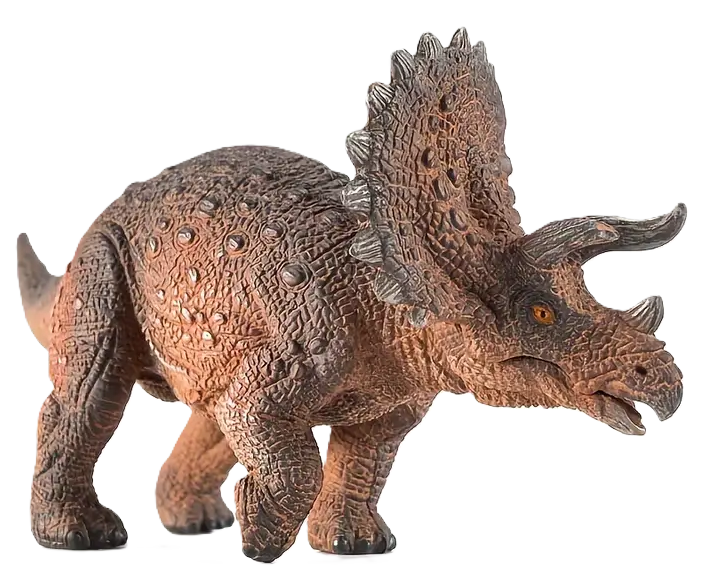
Origins of the Name
The name Triceratops originates from the Greek words tri (three), keras (horn), and ops (face), meaning “three-horned face.” This name was given due to its distinctive skull structure featuring two large brow horns and a smaller nasal horn. The first fossil evidence of Triceratops was discovered in the late 19th century, and the species was formally described by American palaeontologist Othniel Charles Marsh in 1889.
Locations and Distribution
Fossils of Triceratops have been primarily found in North America, particularly in the United States and Canada. The majority of discoveries have occurred in the Hell Creek Formation of Montana, North Dakota, South Dakota, and Wyoming. These fossils date back to the late Cretaceous period, around 68–66 million years ago, making Triceratops one of the last dinosaurs to exist before the mass extinction event.
Physical Characteristics
Triceratops was one of the most recognisable herbivorous dinosaurs, known for its:
- Size: It measured around 9 metres (30 feet) in length and weighed between 6 and 12 tonnes.
- Horns and Frill: The two large brow horns were likely used for defence against predators like Tyrannosaurus rex or for dominance battles within its species. The frill, a bony shield extending from the skull, may have served for protection or display.
- Beaked Mouth: Like modern-day parrots and tortoises, Triceratops had a strong beak for cropping vegetation.
- Quadrupedal Stance: It moved on all four legs, providing stability and strength when foraging or defending itself.
Archaeological Finds and Discoveries
The first Triceratops fossil was mistaken for a bison skull until further analysis confirmed it as a dinosaur. Over 50 complete skulls have been unearthed, making it one of the most well-documented dinosaurs. In 2014, a nearly complete skeleton was discovered in Wyoming, providing new insights into its posture and locomotion. Some palaeontologists believe that Triceratops may have been part of an evolutionary transition leading to Torosaurus, though this theory remains debated.
Interesting Facts
- Triceratops lived alongside the infamous Tyrannosaurus rex, and fossil evidence suggests the two often engaged in fierce battles.
- Unlike some ceratopsians, Triceratops may have lived a more solitary life rather than in large herds.
- It possessed one of the largest skulls of any land animal, sometimes spanning over 2 metres in length.
- Its teeth were arranged in stacked rows, constantly replacing worn-out ones, ensuring efficient plant consumption.
- Despite its bulky frame, Triceratops could move quickly if necessary, using its powerful limbs for agility.
Folklore, Legends, and Tales
While Triceratops itself does not appear in ancient legends, fossil discoveries may have inspired myths of giant horned beasts throughout history. Some believe that early fossil finds contributed to stories of dragons, while others draw parallels between Triceratops and mythical creatures like the griffin due to its formidable appearance.
Links with Astrology and the Chakra System
Astrologically, Triceratops aligns with Taurus, a zodiac sign symbolising strength, stability, and a grounded nature—traits reflected in the dinosaur’s powerful build and defensive capabilities.
In the chakra system, Triceratops is most closely linked to the root chakra (Muladhara), which governs stability, protection, and survival instincts. The strong, grounded energy of this dinosaur resonates with those seeking resilience and strength in their lives. The presence of its third eye-like horn may also connect it to the third eye chakra (Ajna), symbolising intuition and awareness.
Triceratops
Three-horned herbivore of the Late Cretaceous, Triceratops roamed prehistoric plains with frilled armour and fierce presence, majestic and iconic.
